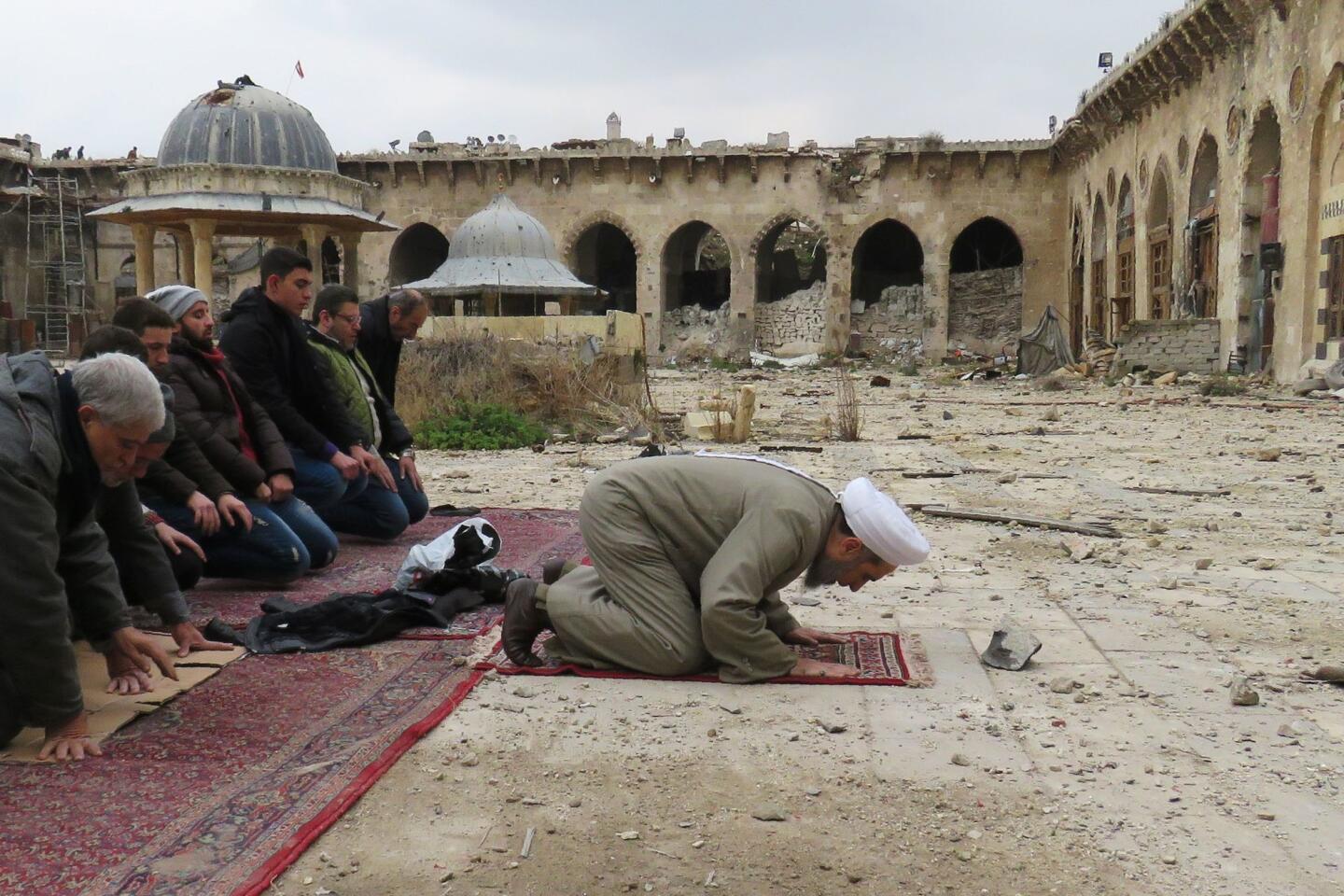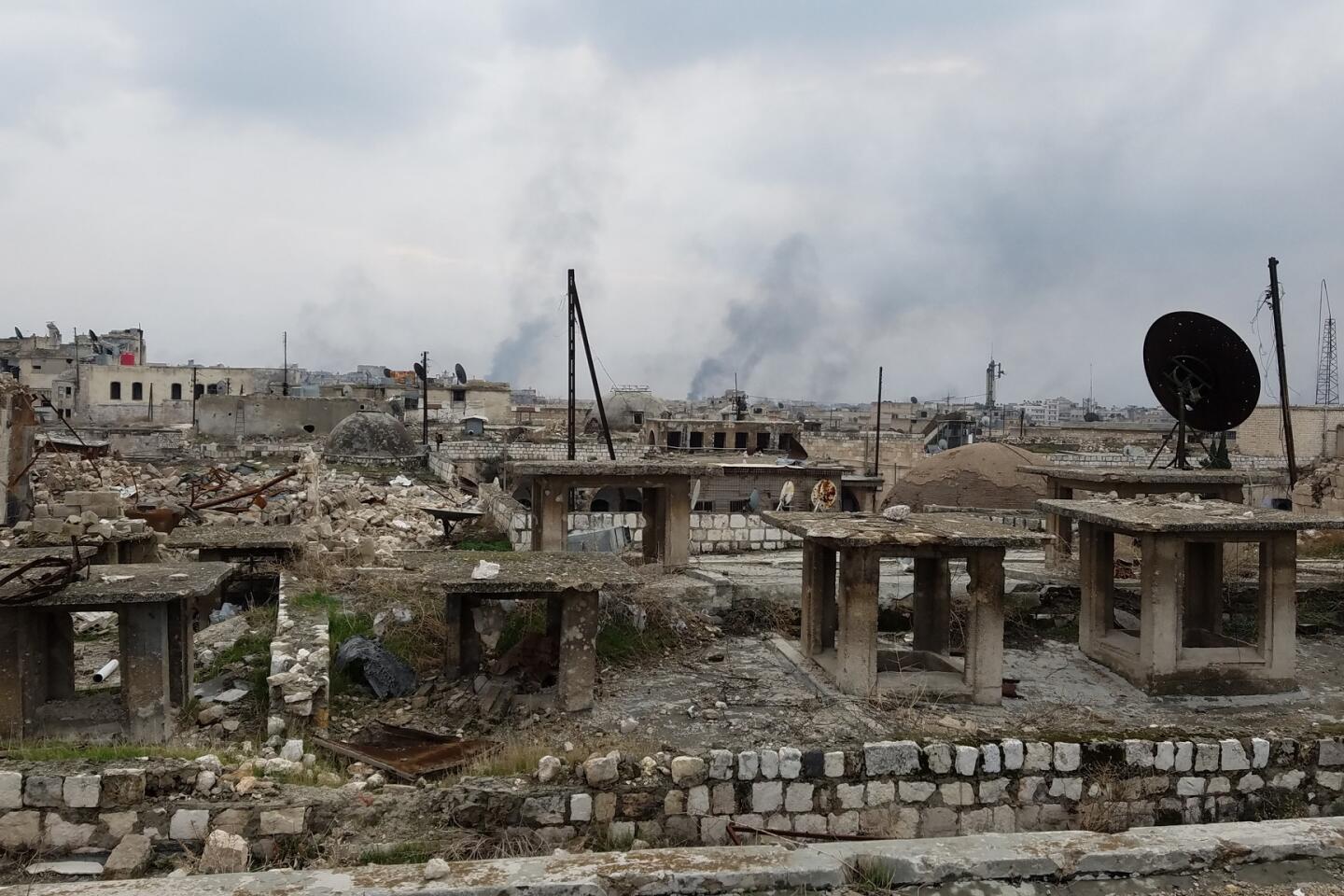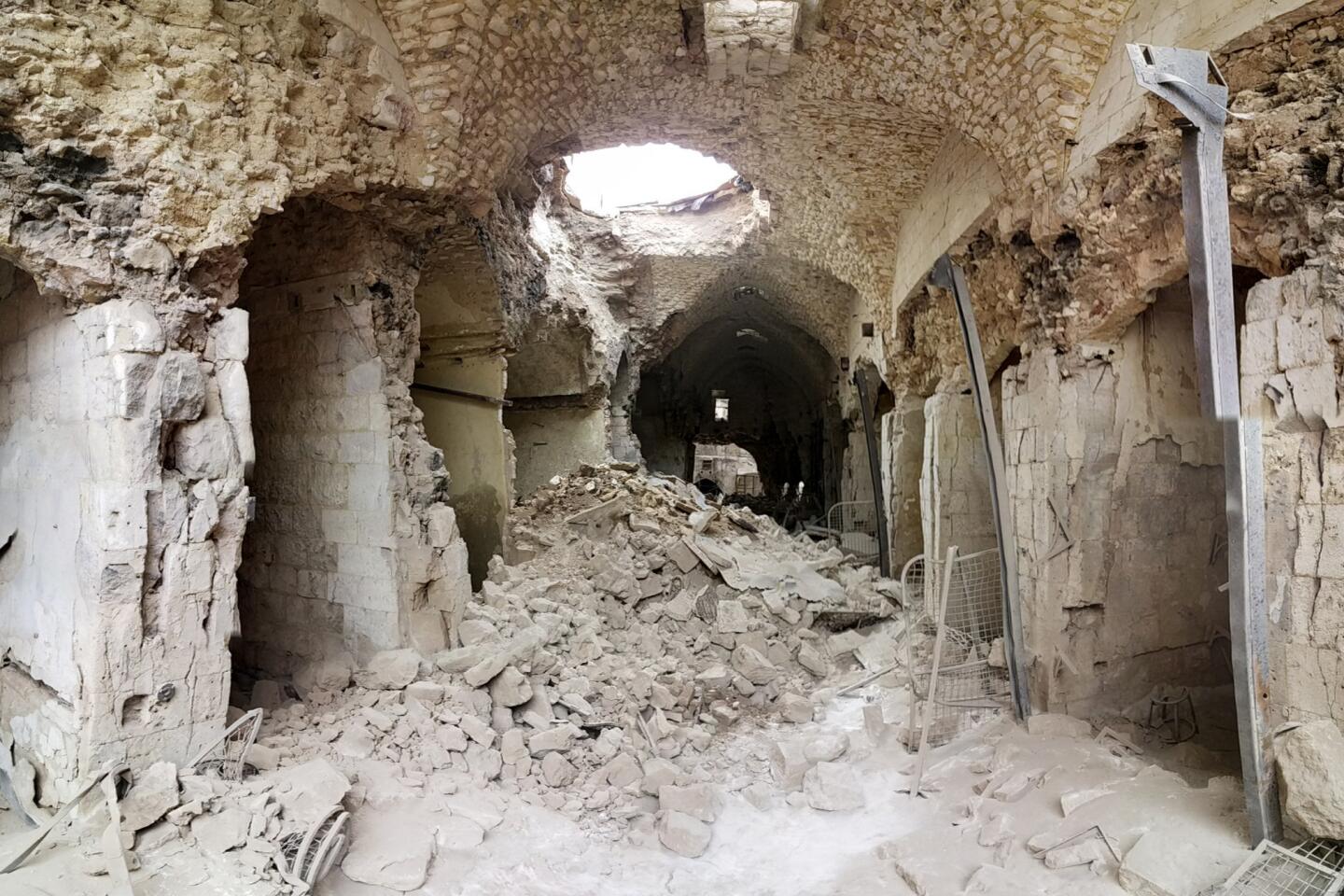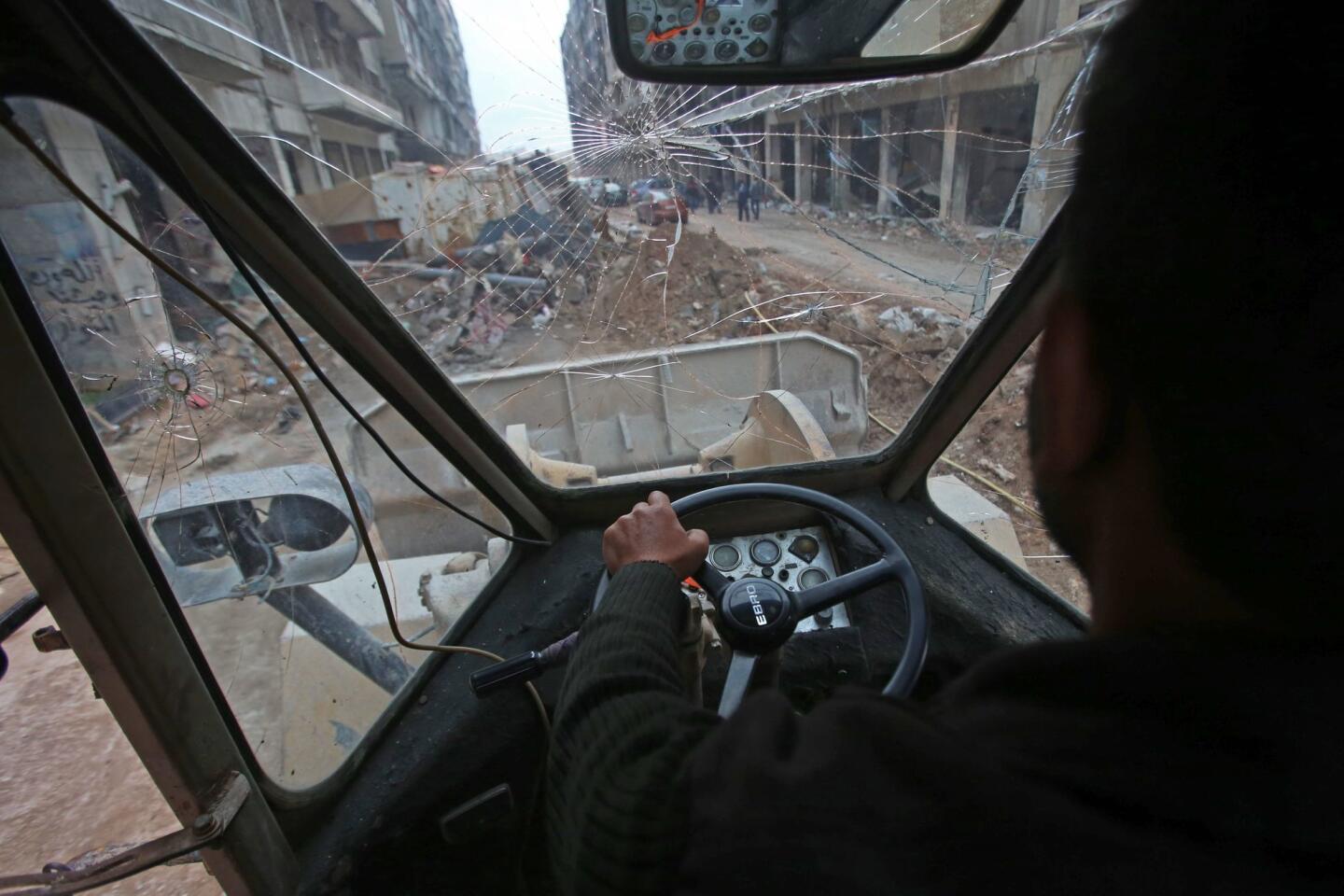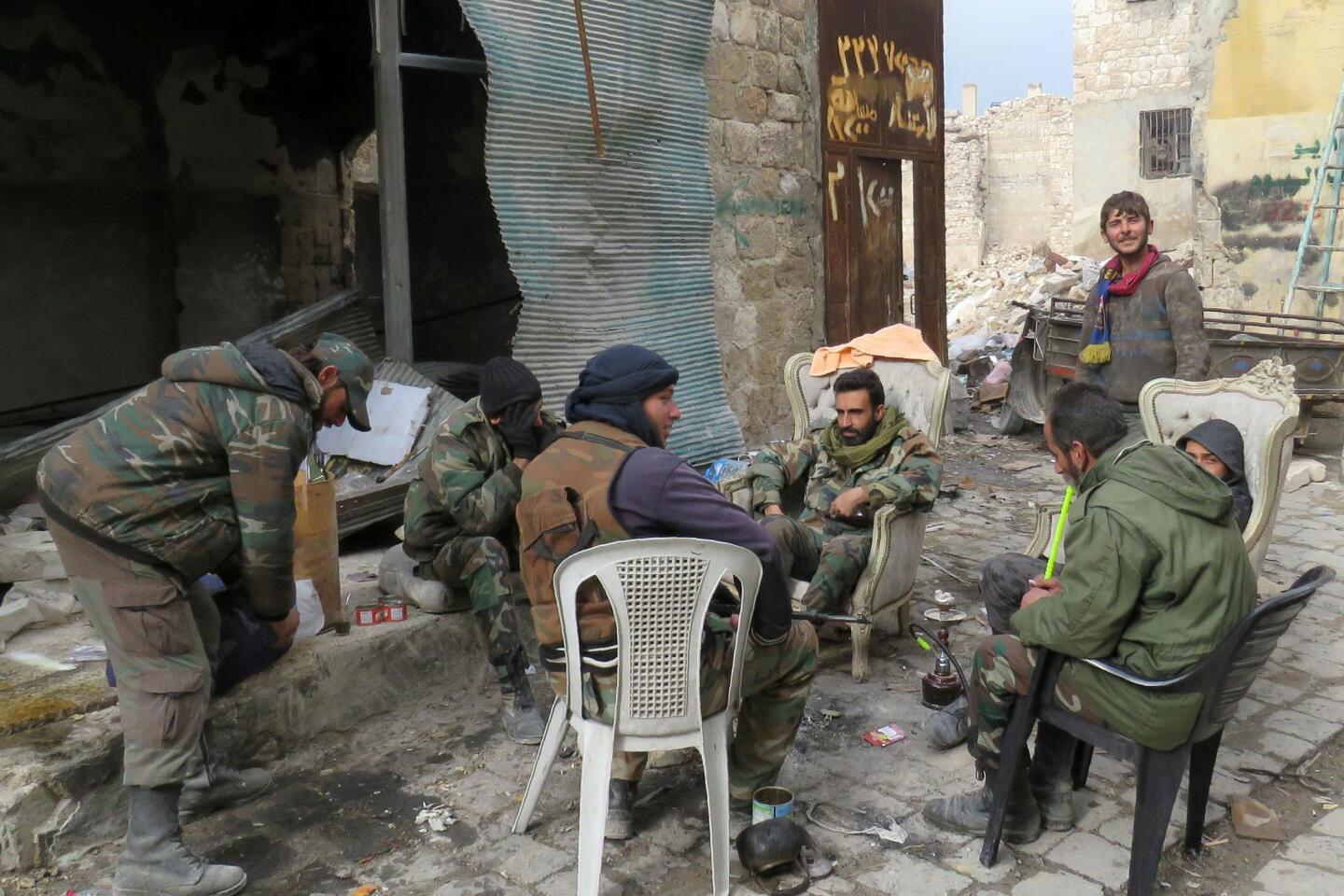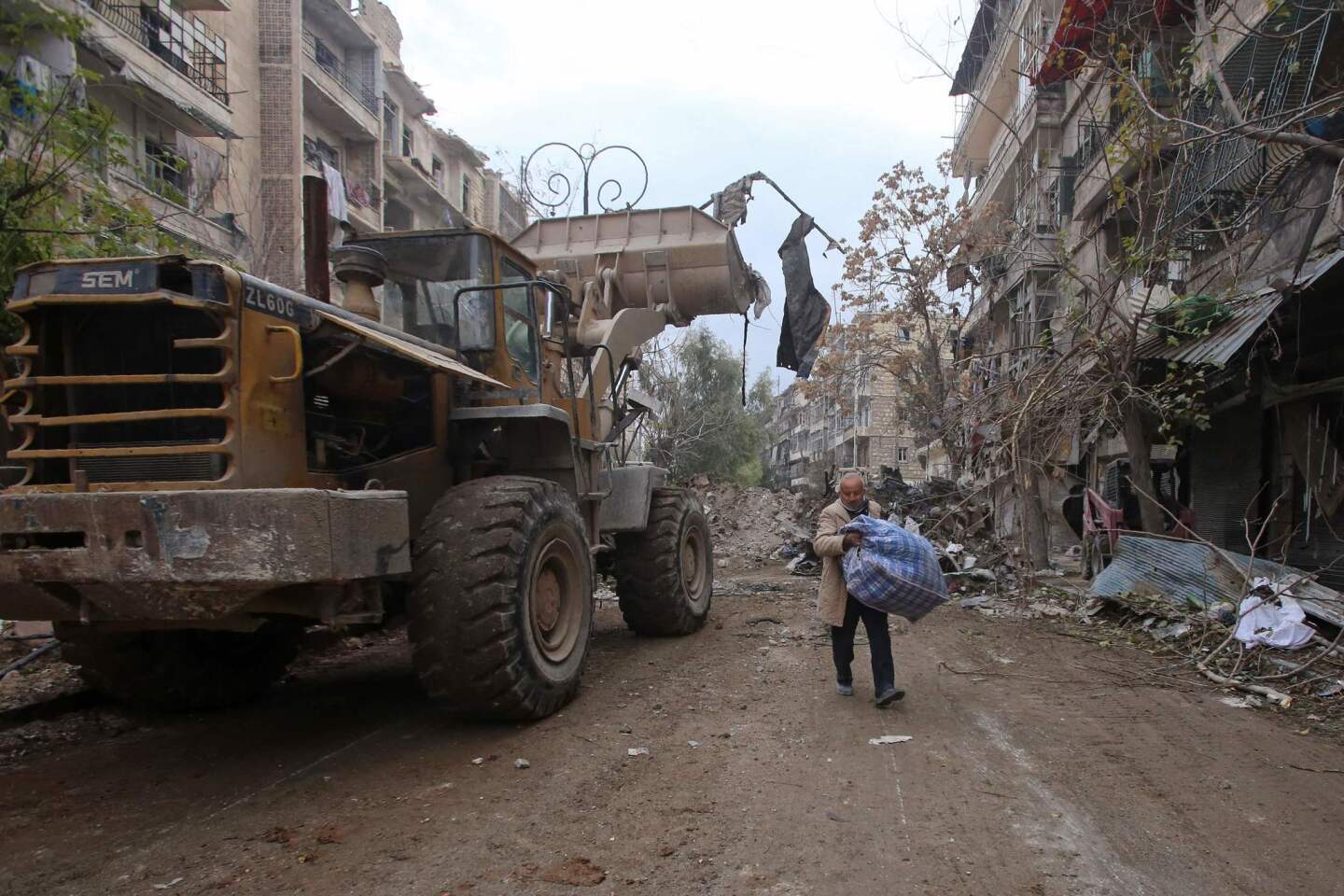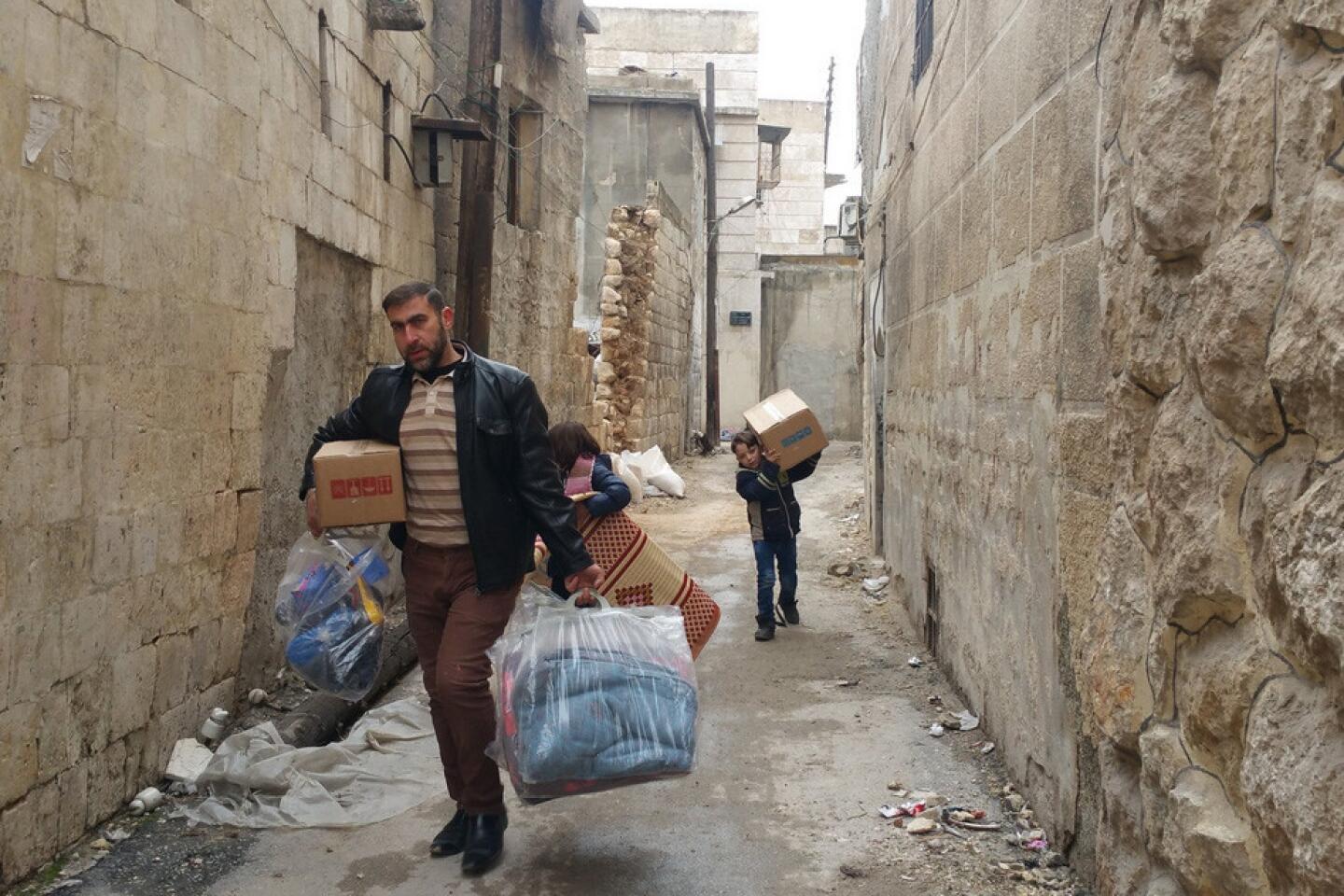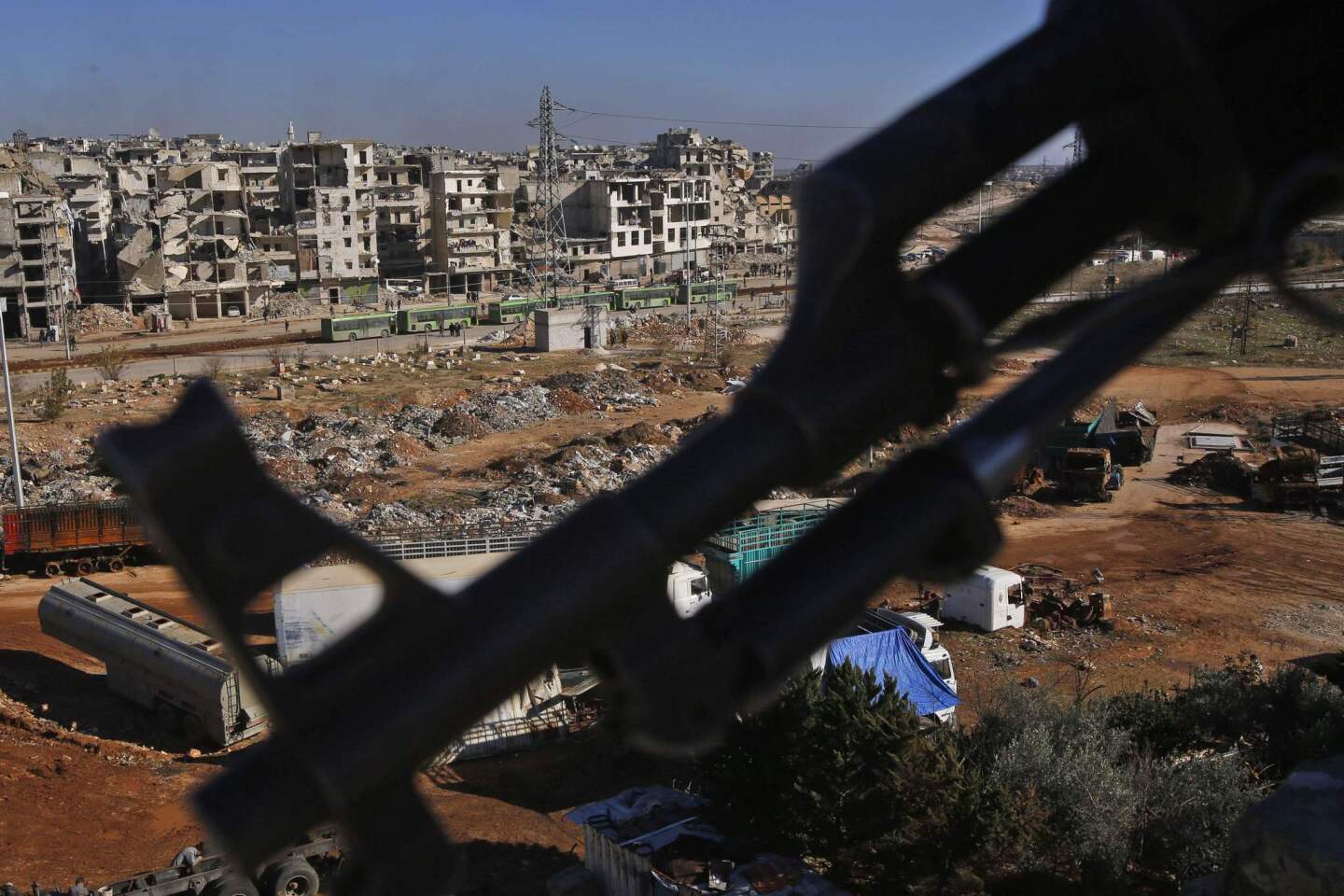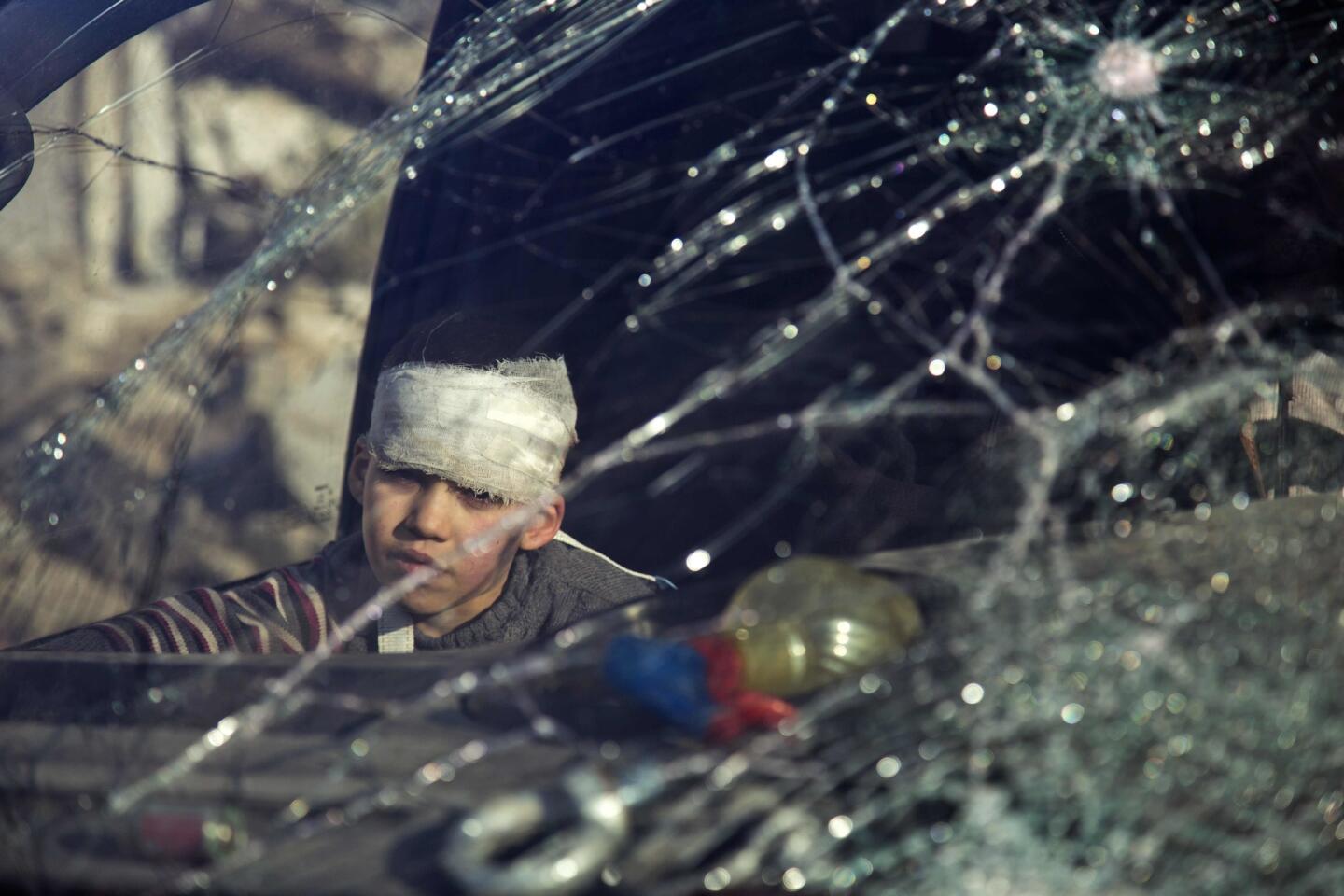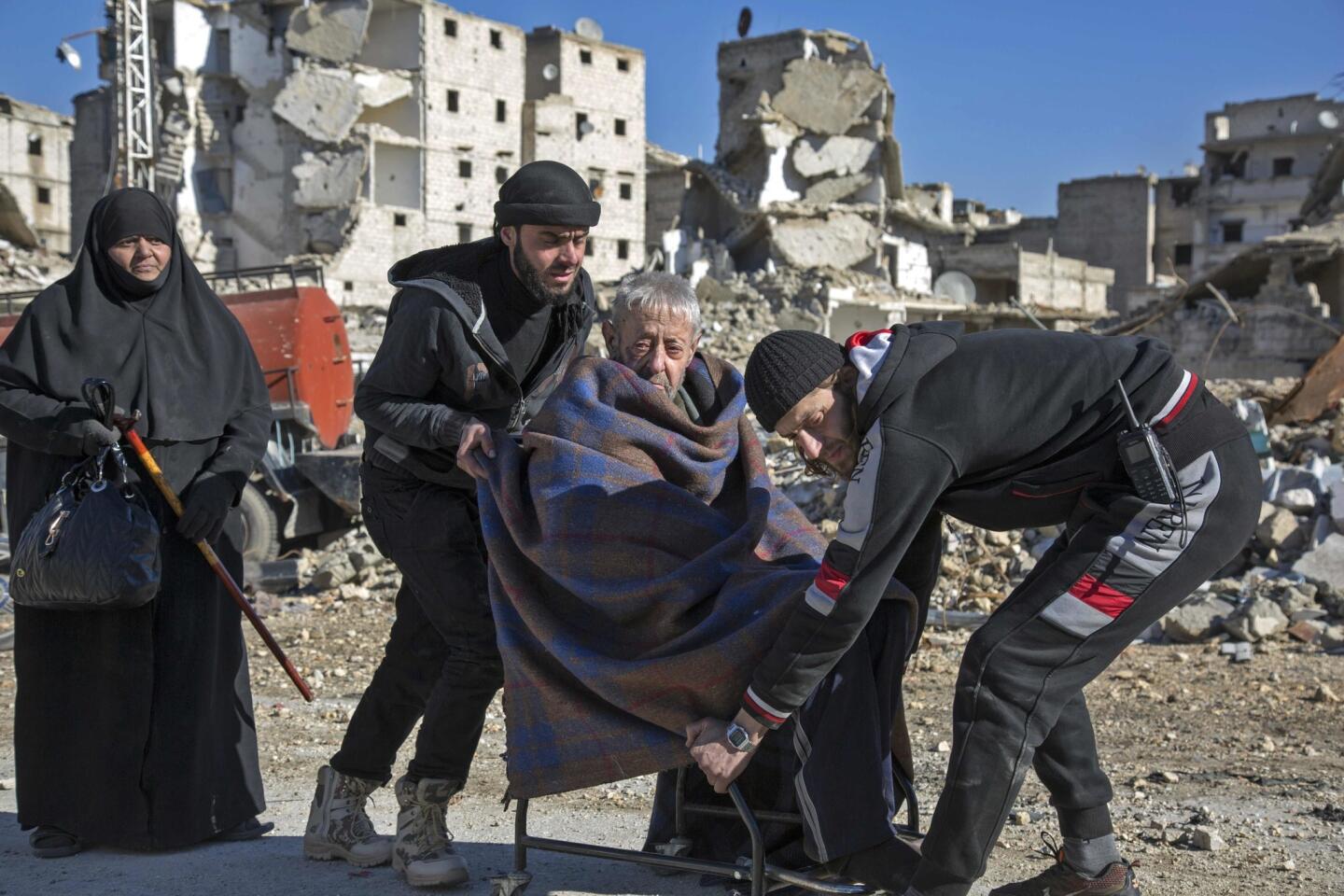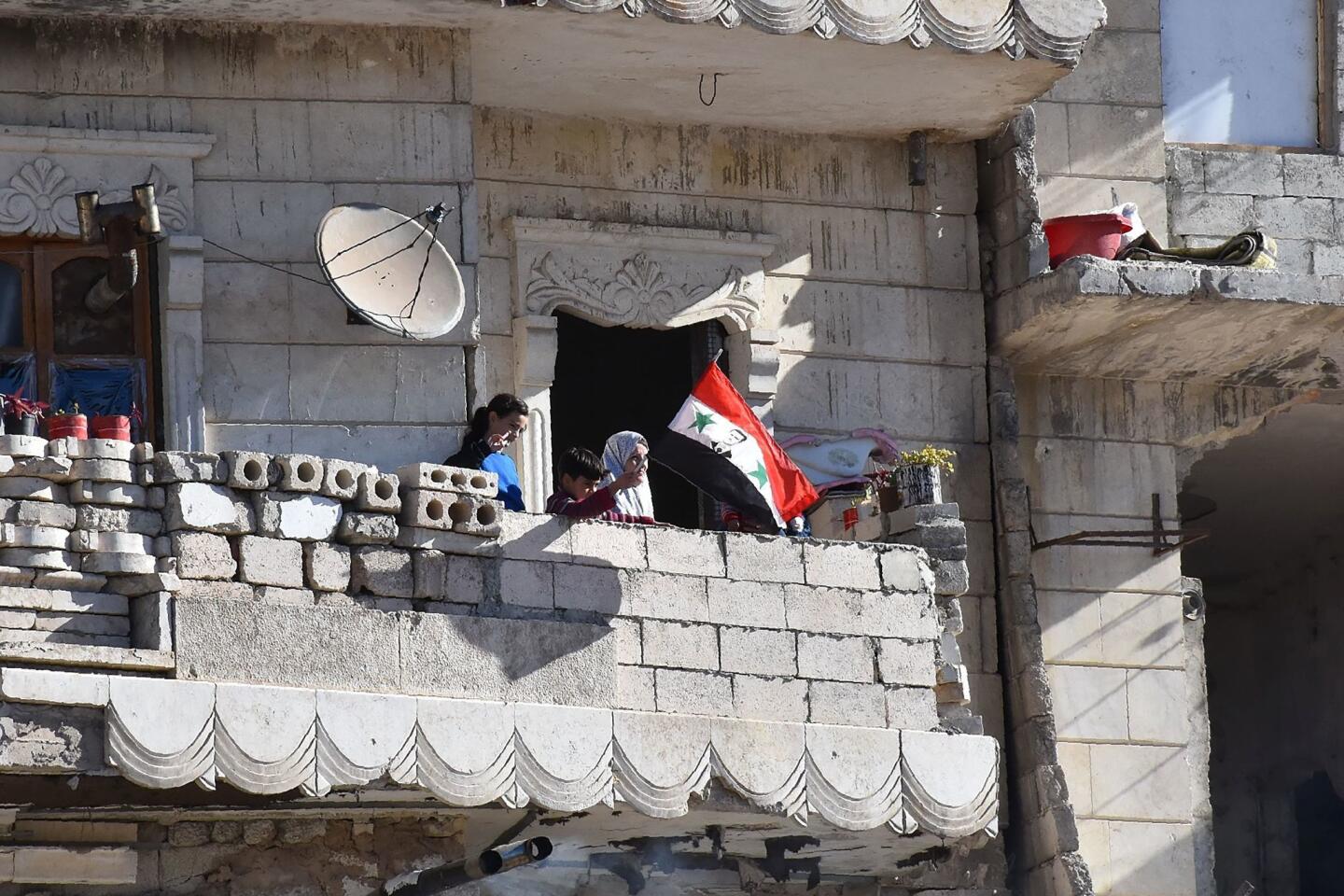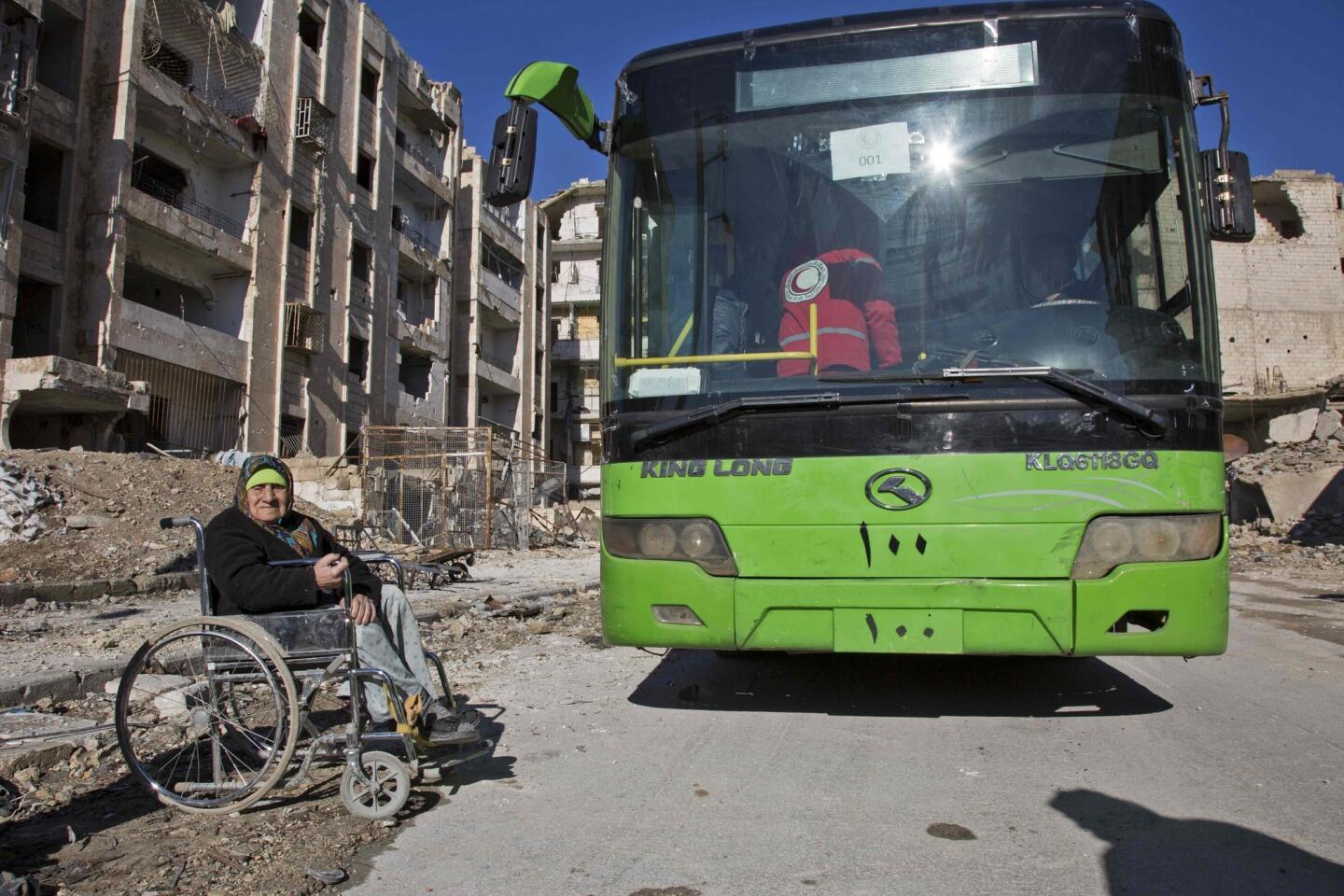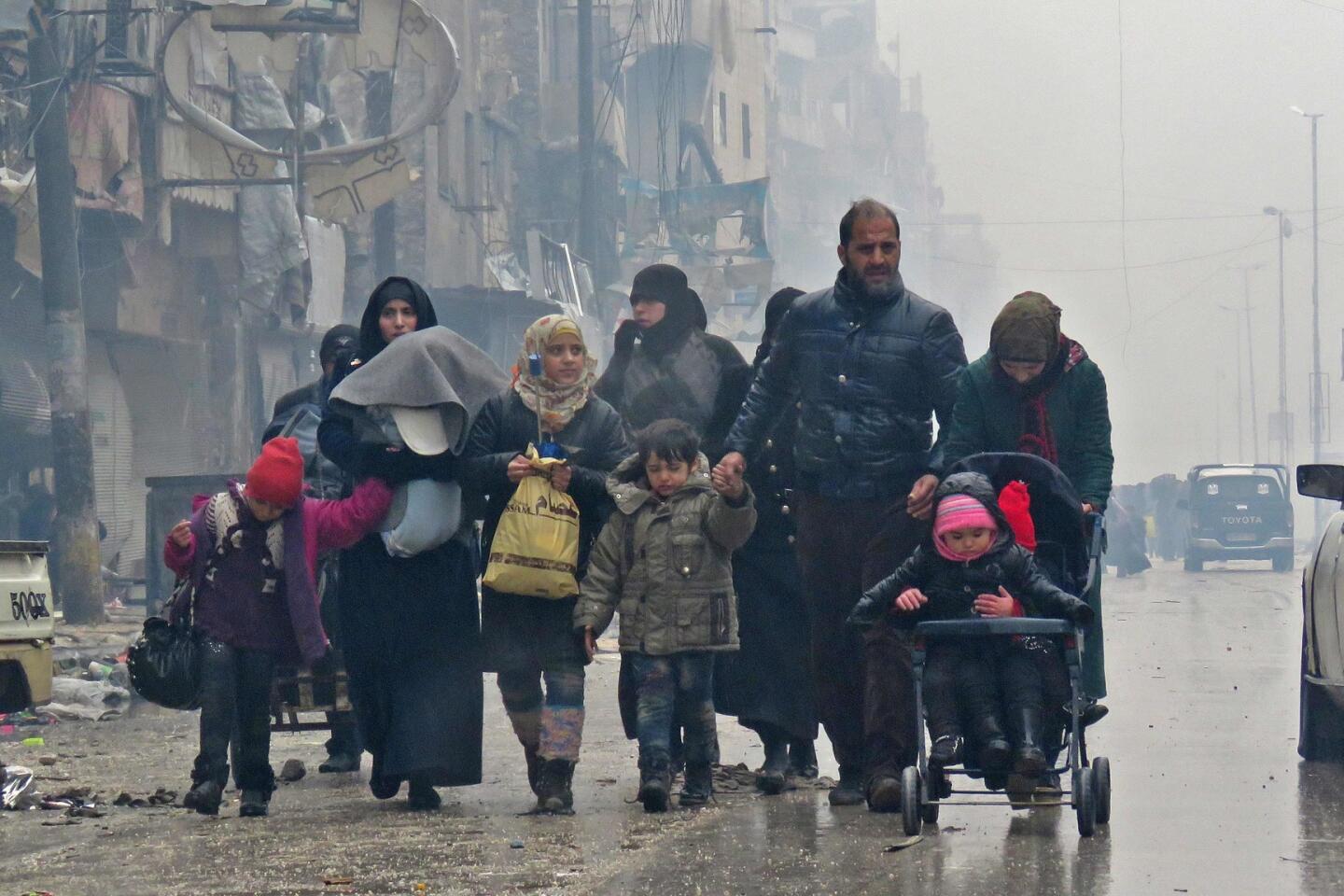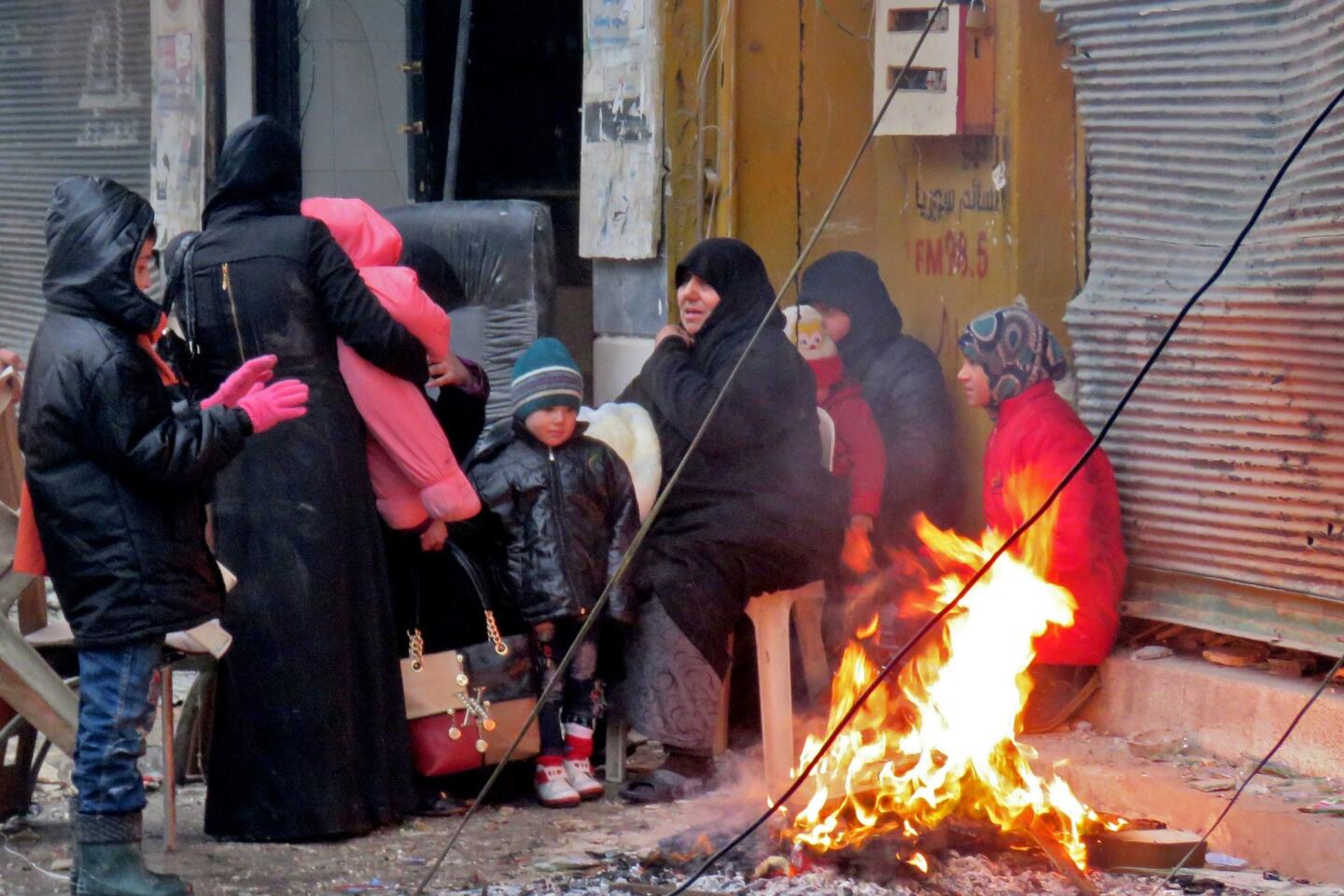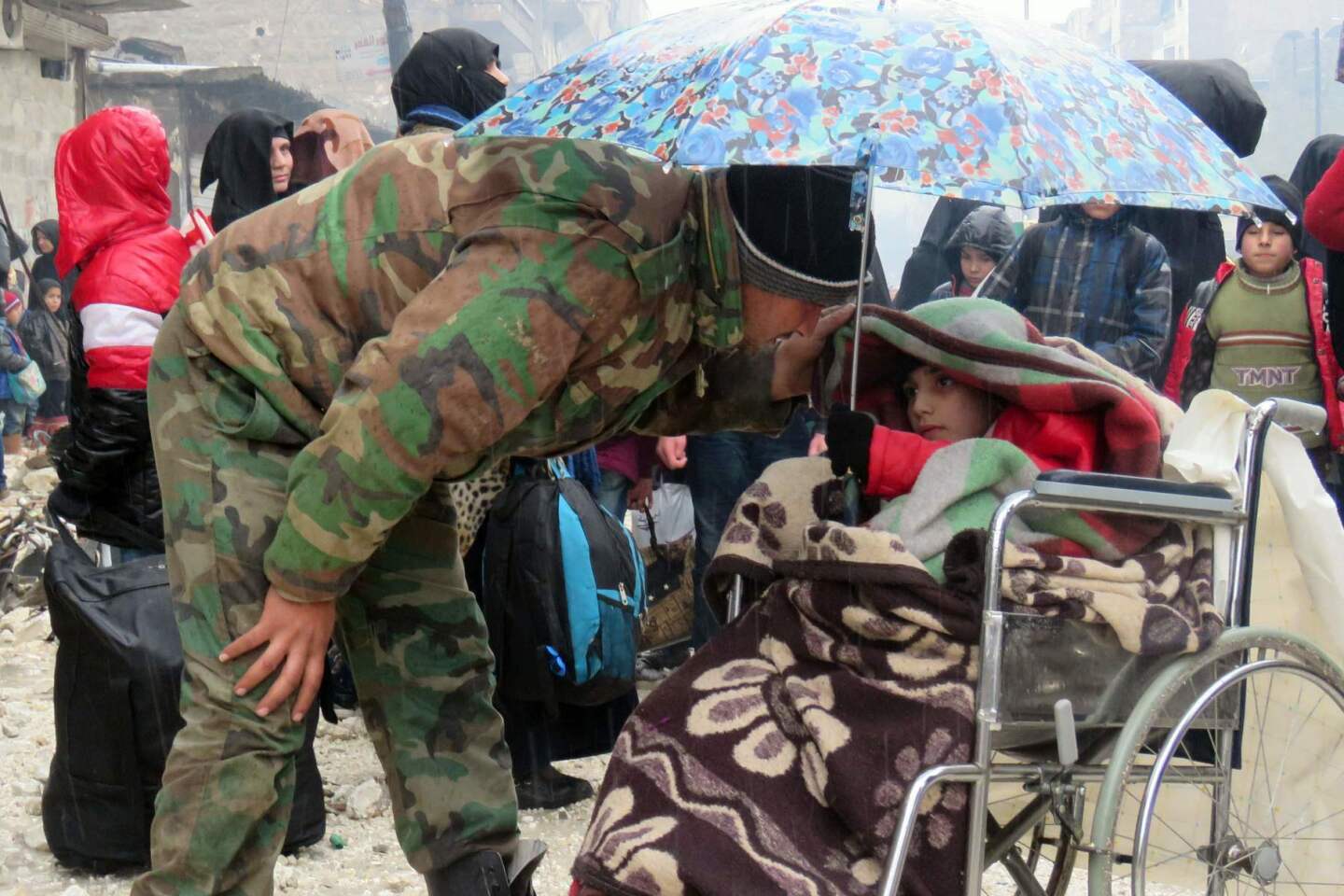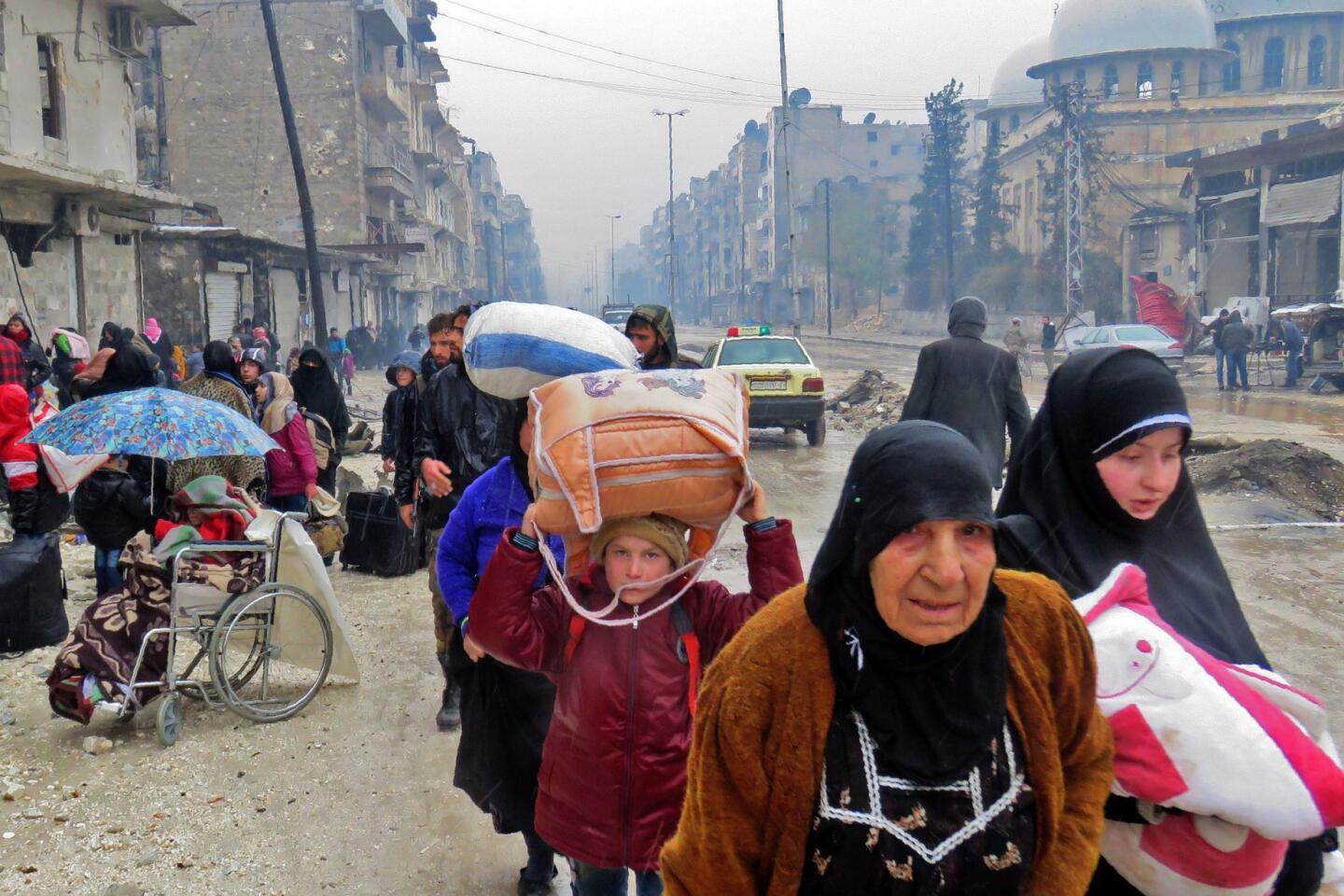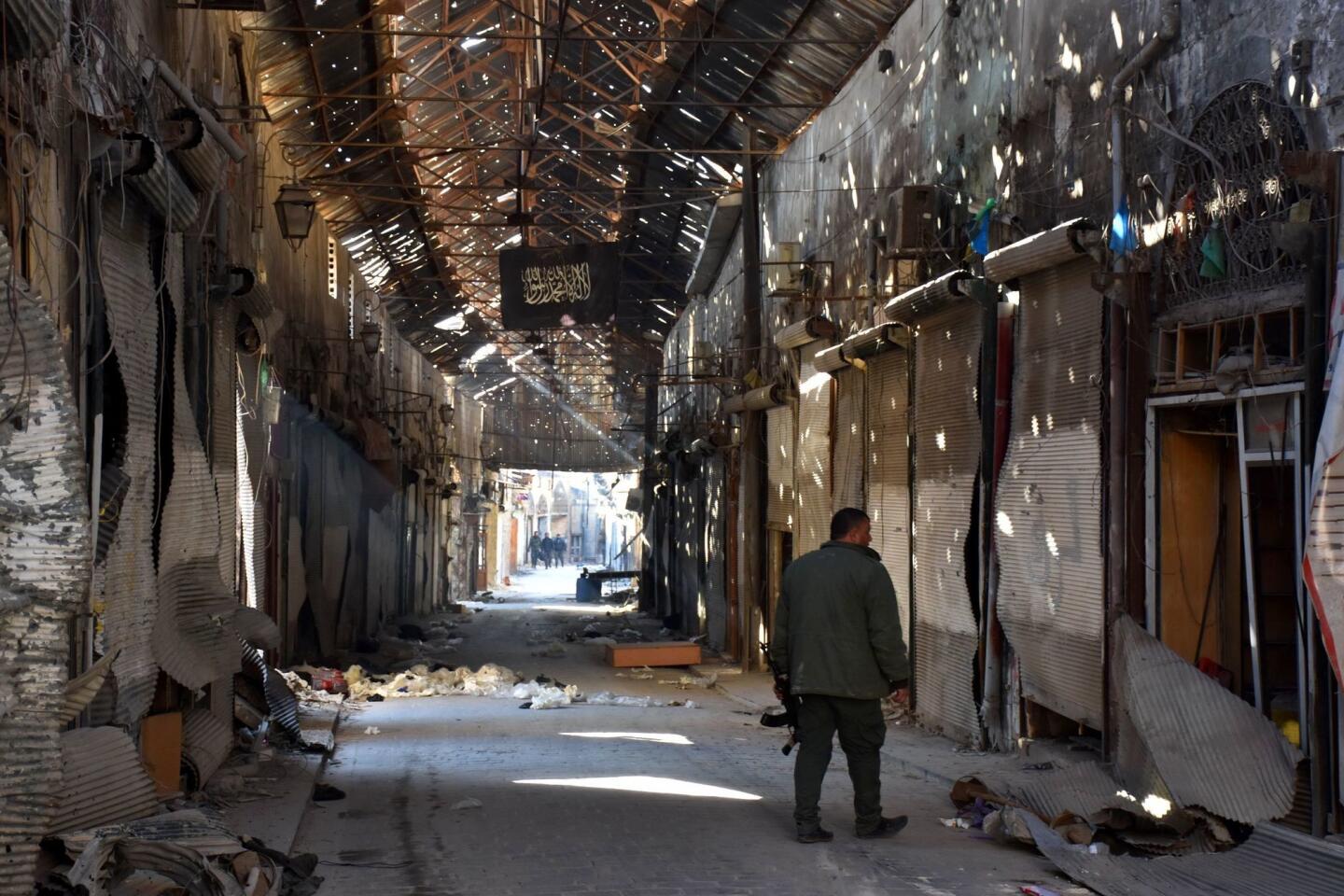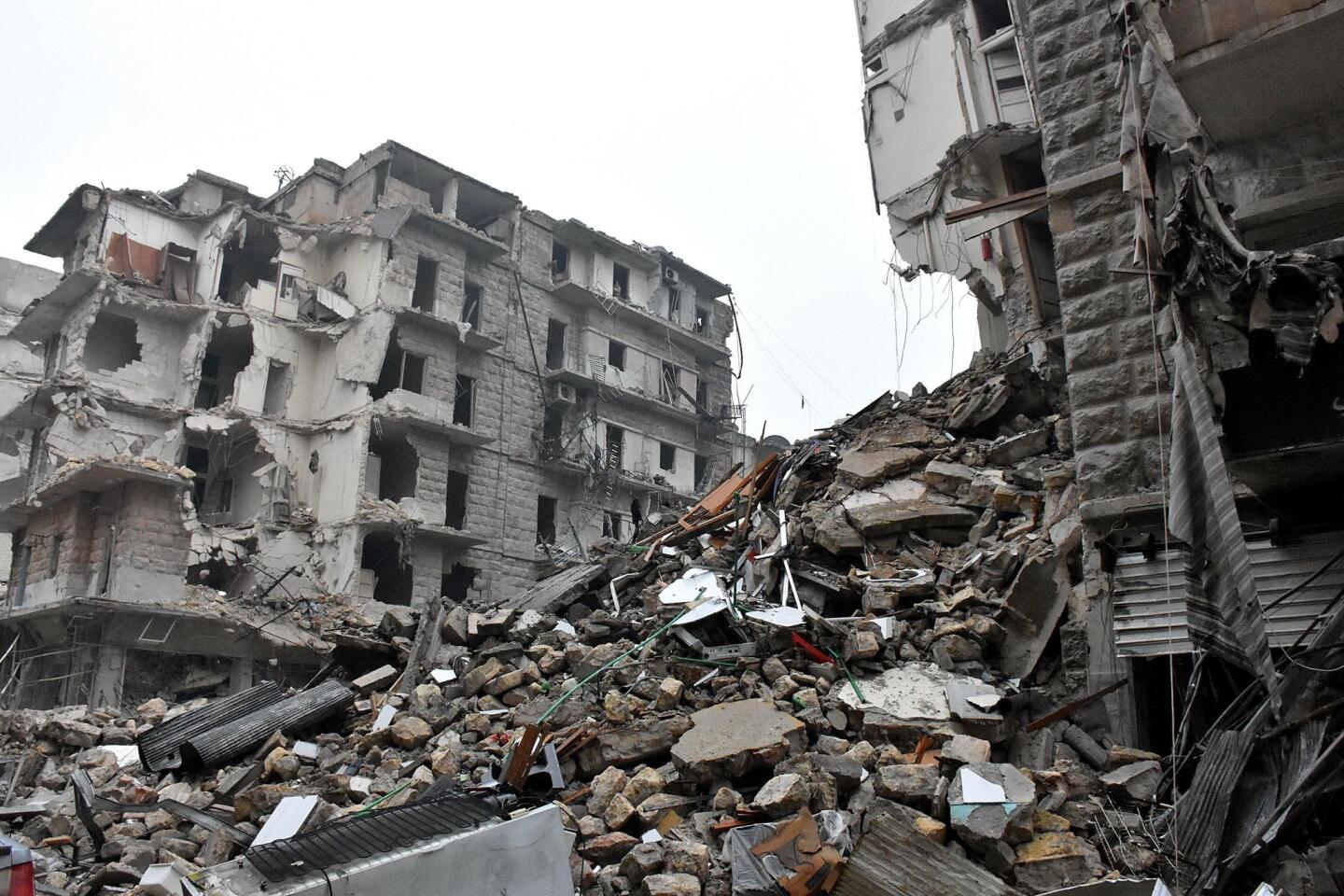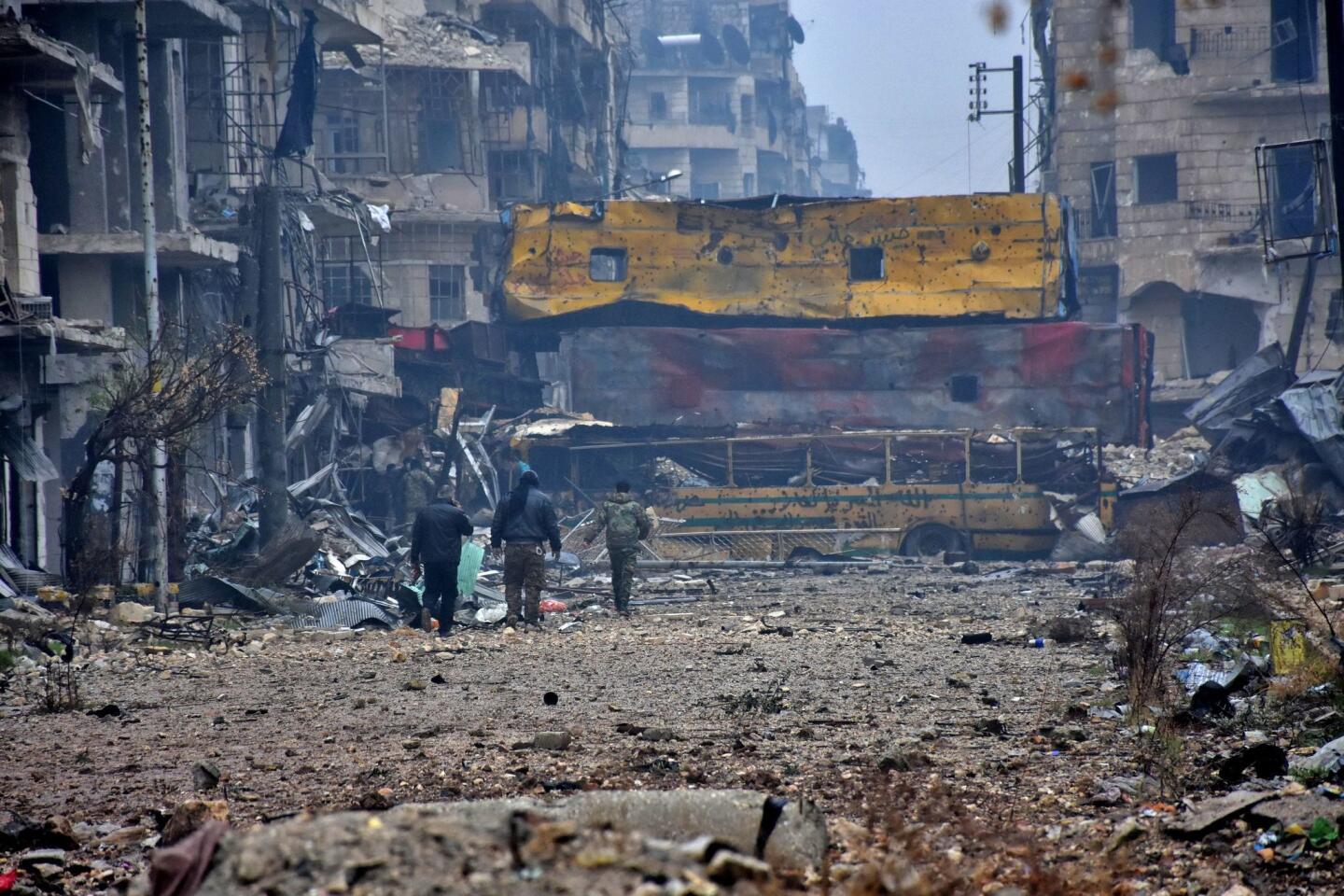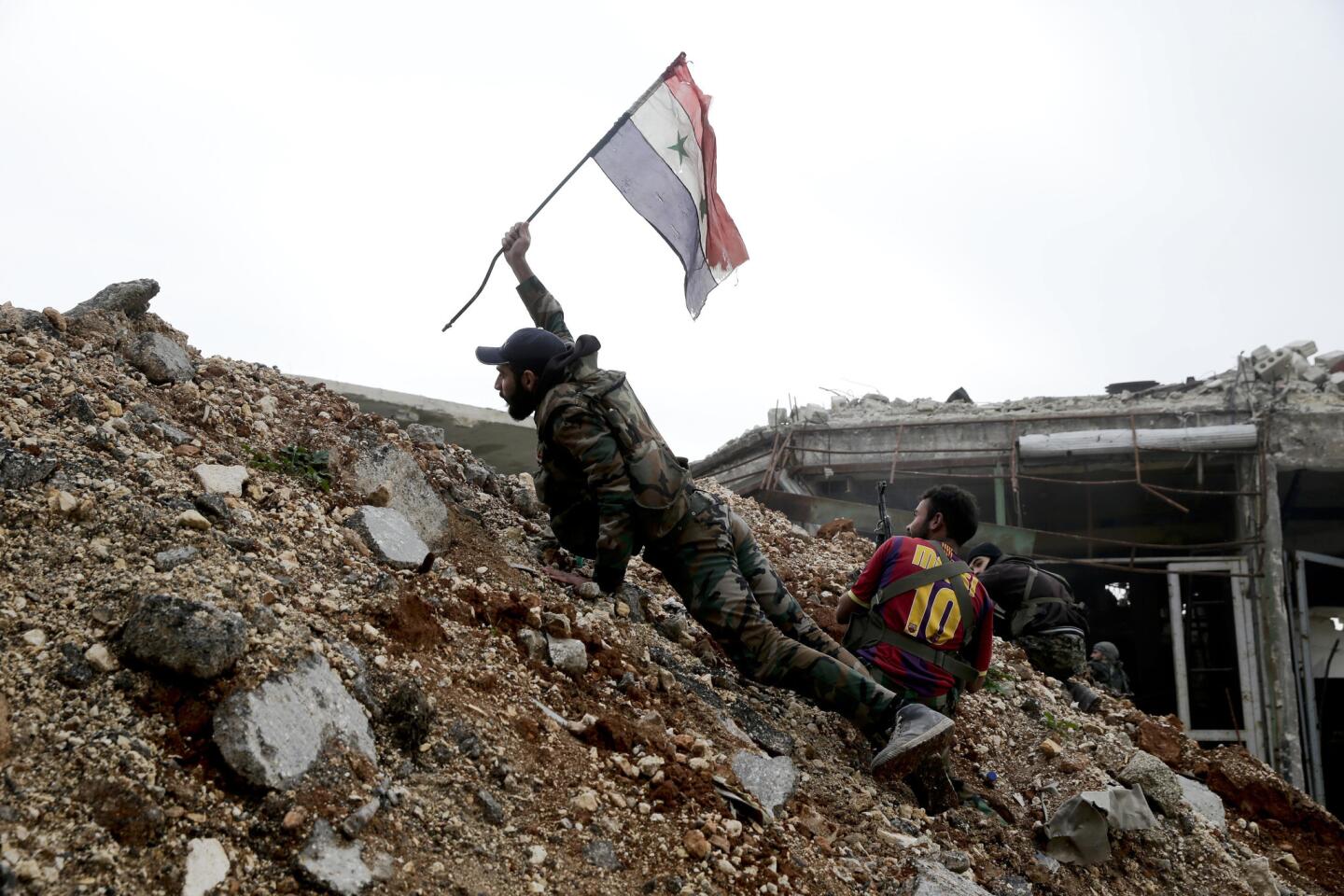Syrian government and rebels blame each other for Aleppo evacuation chaos
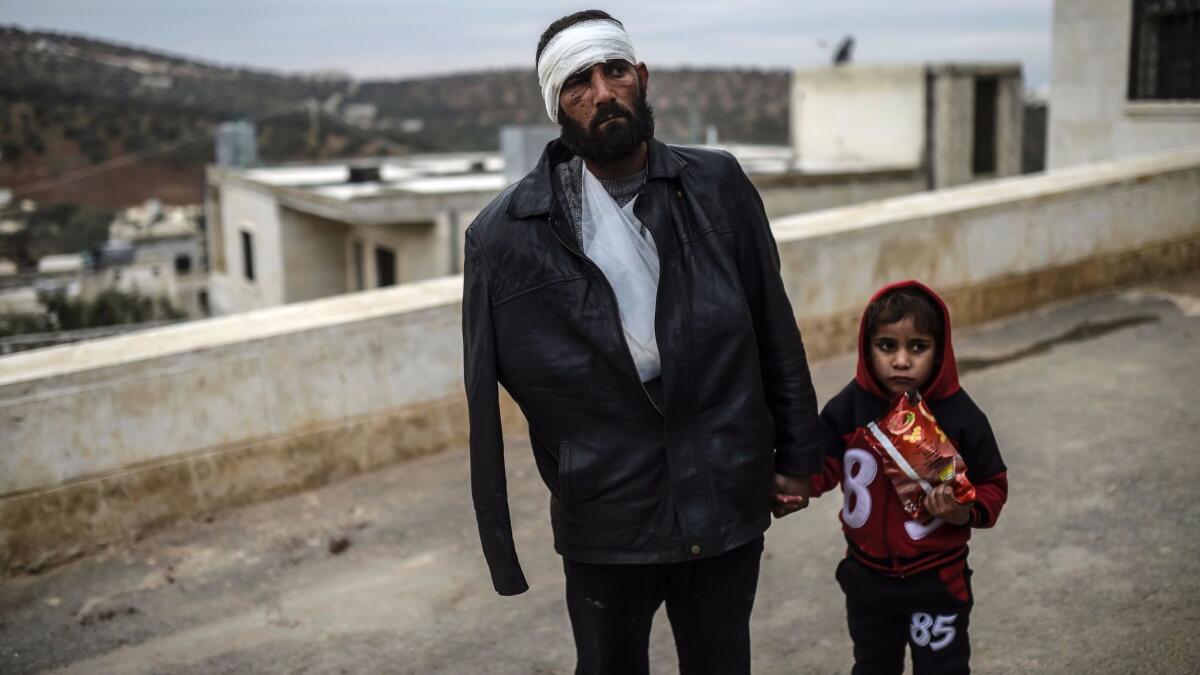
- Share via
Reporting from Aleppo, Syria — The Starliner bus, its white paint speckled with grime, emerged from the bedlam of eastern Aleppo Friday, making its way toward the dilapidated Ramouseh bridge.
It was empty — the residents who’d boarded it earlier in the day to escape the city’s horrors had instead been turned back before reaching safety, as the evacuation of eastern Aleppo was suspended in another round of confusion and mutual blame.
Up to 8,000 people were evacuated between Thursday and Friday night from this embattled northern Syrian city, but at least several thousand remain — possibly as many as 50,000 people — and international officials expressed increasing frustration at the world’s inability to save them.
“The carnage in Syria remains a gaping hole in the global conscience,” U.N. Secretary-General Ban Ki-Moon said as the Security Council met behind closed doors to discuss international monitors for the evacuation. “Aleppo is now a synonym for hell.”
The latest complication came as a convoy of buses, ambulances and cars was seeking to evacuate the eastern portion of the city, where rebels have been making a last stand against the formidable power of the Syrian and Russian armed forces. The convoy was blocked and sent back, amid apparent complications with plans to aid two government-held Shiite villages under siege by the rebels.
There were also accusations on official Syrian media that rebels had attempted to smuggle out captives and heavy weapons from the besieged city.
The blocked convoy returned to an area which, like many parts of this city, has been pummeled by bombs and mortars into a grotesque shell of what it once was.
On one street corner, in the Arqoub neighborhood, stood the rusted remains of a tank which failed to survive an earlier engagement — a grim sentinel standing next to a chaotic jumble of broken-down jalopies and military trucks.
A glimpse down an alleyway, from where an indeterminate pile of rubble could be seen, hinted at the carnage wrought just a few yards away.
It was little better at the city’s outskirts, where pro-government troops and militiamen guarded pulverized hamlets and villages that had been the scene of earlier bouts in the fight between government forces and rebel fighters for ultimate control of Aleppo, Syria’s largest city and possibly its top strategic prize.
The fight is at its last ebb, weeks after pro-government troops launched a do-or-die onslaught on the last remaining opposition-controlled districts — a roughly one-square-mile section of the city without food or substantial medical help that has become a scene of desperation.
Those who have succeeded in leaving the city were expressing a mixture of elation at their escape, fear for those left behind, and recriminations for their loss.
“I’m with my wife and kids. I was able to leave with my brothers and we left very early this morning,” said Diaa Absi, who managed to reach safety in the city of Idlib.
When congratulated for having survived the ordeal, Absi’s voice turned regretful.
“What congratulations? We lost the land,” he said. “We lost the land that we will never see in our lifetime.”
Mohammed Seddaway, who also was evacuated on Friday, said he had to leave with nothing.
“I didn’t take anything with me,” he said. “They were bombing my house. I left behind me beautiful memories.”
President Obama on Friday expressed sorrow over the devastation in Aleppo but said there was no way for the United State to intervene and stop the slaughter in Syria “on the cheap.”
“We cannot claim we have been successful” in efforts to stop the Syrian bloodshed, Obama said at a news conference in Washington. “So that is something I have to go to bed with every night.”
But referring to his decision to avoid direct military involvement in Syria’s civil war, he added: “I continue to think it was the right approach.”
Obama has held back from directly taking on the government of Syrian President Bashar Assad, insisting that no military solution is possible, and that any resolution of the conflict must be a political one.
The precise reason for the suspension of the evacuations Friday remained unclear, but it reflected both the fragility of the ceasefire agreement and the uneasy relations of its architects.
Pushed into execution by Turkey and Russia, the deal requires the acquiescence of Damascus and Iran, as well as a sign-off from a rebel umbrella group of Islamist factions called the Army of Conquest.
The latest agreement linked the fate of the besieged residents of Aleppo to those living in Foua and Kfarya, a pair of Shiite-dominated towns located less than 30 miles to the southwest that have also been subjected to a punishing blockade and constant shelling by the rebels.
Although the two towns were not originally part of the deal, they were added after the first attempt at an evacuation on Wednesday collapsed.
On Friday, as the new evacuations were under way, Syrian state media accused the rebels of violating the terms of the deal by smuggling kidnapped captives and heavy weaponry, including tank-busting TOW missiles, in one of the convoys that had left overnight.
The Syrian Arab News Agency reported that “terrorist groups” targeted the convoy “with sniper fire and mortars” near Ramouseh.
“The suspension ... will continue until guarantees are reached that obligate the terrorist groups to adhere to all the agreement’s conditions,” an unnamed source was quoted as saying.
Meanwhile, Russia, a staunch ally of the Assad government and one of the main proponents of the evacuation, said the operation had ended.
“All civilians and the bulk of militants have left the blocked quarters,” the chief of the Russian army’s General Staff, Lt. Gen. Sergey Rudskoi, said in a media briefing in Moscow, according to the semi-official Russian news agency, TASS.
“The operation to clear Aleppo of terrorists is over. Government troops are wiping out scattered groups of radicals who have refused to leave the city,” it said.
But Pawel Krzysiek, spokesman for the International Committee of the Red Cross in Syria, said Friday that there were still “plenty of people waiting to leave.”
Ban Ki-moon said the U.N. stood ready to assist as needed to help rescue as many people as possible.
The U.N. earlier estimated that about 50,000 people remain in the one square mile of territory left to the rebels in Aleppo. Reliable population numbers are hard to come by, however. Some put the number at 15,000, while still others say 40,000 remain.
Central Combat Media, a pro-government media outlet, estimated that approximately 1,100 rebels remain, along with a few thousand civilians.
Ahmad Qura Ali, spokesman for the hardline Islamist group Ahrar Al Sham, blamed “Iran and its sectarian militias” for blocking the evacuation of Aleppo, in a reference to the Shiite irregulars from Lebanon, Iraq and Afghanistan that have been dispatched to strengthen government troops.
“[They] obstructed the agreement to pressure the… factions in the issue of Kfarya and Foua,” he said.
Iran was instrumental in creating the agreement that spared Foua and Kfarya from being overrun by the rebels, almost two years ago.
However, Hussein Mourtadha, a correspondent for the Iranian broadcaster Al-Alam, reported that it was relatives of those in Foua and Kfarya who had blocked the path of the convoy. They were protesting the rebels’ blocking of dozens of buses destined for the two towns with the aim of emptying them.
Later on Friday, pro-opposition activists said the Army of Conquest would allow the evacuation of the two towns to go through, and residents in Foua and Kfraya appeared hopeful. “There are four thousand people ready to leave, including the sick as well as women and children,” Mohammad Hassan Taqi, head of the towns’ crisis committee, said in a text on the WhatsApp messaging service on Friday.
“We were told that the buses…. will reach here on Saturday.”
Even with Aleppo mostly back under government control, the war is far from over. Late on Friday, a police building in the capital Damascus, more than 200 miles south of Aleppo, was the scene of a suicide bombing.
The bomber, official Syrian government outlets said, was a little girl donning a remotely detonated explosive belt. She was 7years old. The reports could not be independently confirmed.
Bulos is a special correspondent. Times staff writers Christi Parsons in Washington and Molly Hennessy-Fiske in Irbil, Iraq, contributed to this report.
ALSO
The U.S. is helping train Iraqi militias historically tied to Iran
Fears of Russia and Trump drive EU leaders to boost defense budgets
Syria’s Assad hails ‘the liberation of Aleppo’ as evacuations begin from devastated city
UPDATES:
6:10 p.m.: This story was updated with quotes from another evacuee.
4 p.m.: This story was updated throughout with staff reporting.
This story was originally published at 8:25 a.m.
More to Read
Sign up for Essential California
The most important California stories and recommendations in your inbox every morning.
You may occasionally receive promotional content from the Los Angeles Times.
